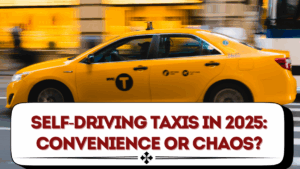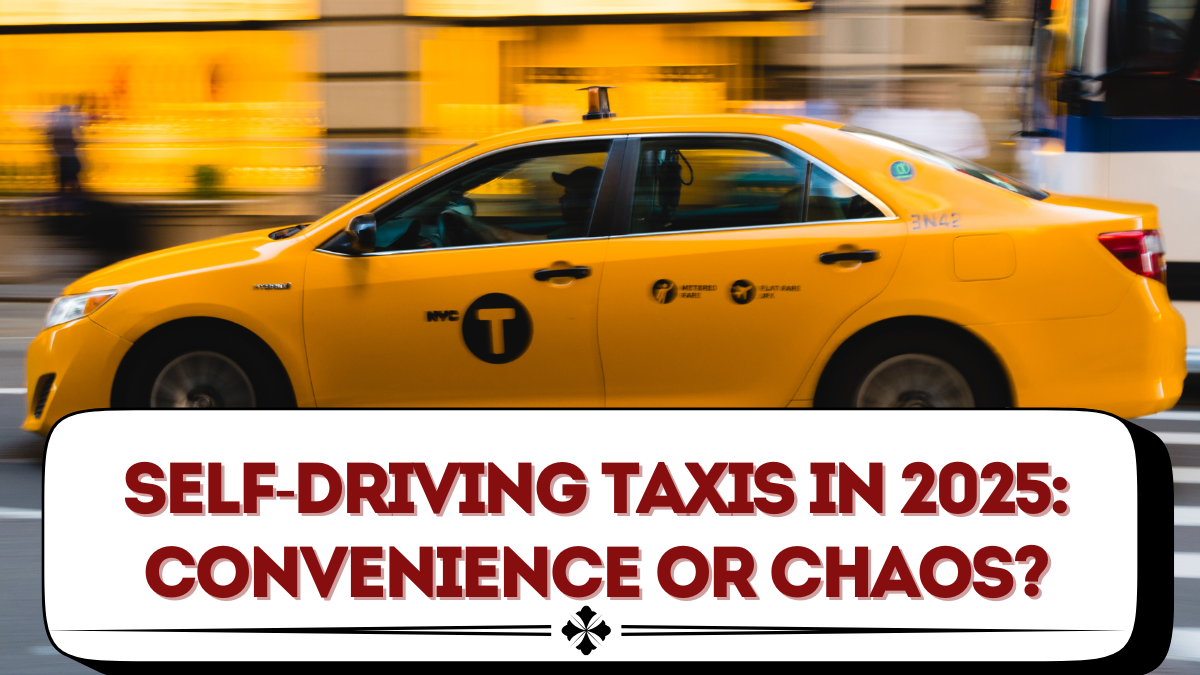The vision of summoning a car that drives itself has moved from science fiction into everyday reality. In 2025, self-driving taxis—also known as robo-taxis—are expanding across cities worldwide. Powered by artificial intelligence, sensors, and advanced navigation systems, these vehicles are transforming urban mobility.
Yet, while the convenience of driverless transport is undeniable, concerns over safety, regulation, and city readiness remain. The question isn’t whether self-driving taxis will become part of modern life—it’s whether they will deliver smooth convenience or spark new forms of chaos.

What Are Self-Driving Taxis?
Self-driving taxis are fully or semi-autonomous vehicles that operate without a human driver. Managed by mobility platforms or automakers, these taxis use AI systems, cameras, radar, and LiDAR sensors to navigate roads, identify hazards, and transport passengers safely.
Unlike traditional ride-hailing services, robo-taxis don’t rely on human drivers, making them available 24/7 and potentially reducing operating costs.
The Rise of Robo-Taxis in 2025
2025 marks a turning point for robo-taxis, with companies such as Waymo, Tesla, Cruise, and Baidu rolling out fleets in major cities. Governments in the U.S., Europe, and Asia are granting permits for commercial operations, and public acceptance is growing steadily.
Key factors behind this growth:
-
Advances in AI and sensors making autonomy more reliable.
-
Urban congestion fueling demand for smarter mobility solutions.
-
Rising labor costs making driverless taxis attractive to operators.
-
Consumer appetite for fast, app-based transport.
Benefits of Self-Driving Taxis
-
Convenience – Available on-demand through apps with minimal wait times.
-
Cost Savings – No driver salaries mean fares could be cheaper long term.
-
Accessibility – Helpful for elderly or disabled passengers who can’t drive.
-
Safety Potential – Reduced human error, which accounts for over 90% of road accidents.
-
Environmental Impact – Many robo-taxi fleets use electric vehicles, reducing emissions.
Challenges and Concerns
Despite progress, self-driving taxis bring challenges that cities must address:
-
Safety Risks – AI misjudgments or sensor failures can still cause accidents.
-
Job Losses – Traditional taxi and rideshare drivers risk displacement.
-
Regulatory Uncertainty – Laws vary widely between regions, slowing adoption.
-
Cybersecurity – Hacking risks pose threats to passenger safety and privacy.
-
Infrastructure Gaps – Many cities lack roads and networks optimized for autonomous fleets.
Robo-Taxi Models Emerging in 2025
1. Fully Autonomous Robo-Taxis
No steering wheel or pedals. Operates entirely on AI in geofenced urban areas.
2. Semi-Autonomous Fleets
Driverless for most of the journey but monitored by remote human operators for safety.
3. Shared Autonomous Shuttles
Larger vehicles designed for group rides, blending ride-sharing with autonomy.
Comparison of Benefits vs Challenges
| Aspect | Benefits | Concerns |
|---|---|---|
| Convenience | 24/7 availability, fast booking | Unequal access in rural areas |
| Cost | Lower fares in long term | High initial investment |
| Safety | Removes human error | AI errors & sensor malfunctions |
| Jobs | New tech jobs in AI & maintenance | Loss of traditional driver jobs |
| Environment | Cleaner EV fleets | Power grid strain from EV demand |
This balance shows why adoption is fast but still cautious.
Global Expansion in 2025
-
United States – Waymo and Cruise expanding in California, Arizona, and Texas.
-
Europe – Robo-taxi trials in Germany and France with government backing.
-
China – Baidu Apollo and Pony.ai leading large-scale deployments.
-
India – Early pilot programs in smart cities, focusing on EV-based robo-taxis.
Global adoption highlights both opportunity and challenges, especially in regions with less-developed infrastructure.
FAQs
Are self-driving taxis safe in 2025?
Yes, safety has improved significantly, but AI-driven systems still face challenges in unpredictable environments.
How much do self-driving taxis cost compared to normal taxis?
Currently, fares are similar or slightly lower, but costs are expected to decrease as fleets expand.
Will robo-taxis replace traditional taxis?
Not completely in the short term. Human-driven taxis will remain important, especially in rural and complex driving areas.
Do robo-taxis run on electricity?
Most fleets are electric, contributing to cleaner urban air and lower carbon emissions.
Can anyone summon a self-driving taxi?
Yes, in supported cities, passengers can book robo-taxis via apps just like regular ride-hailing services.
Conclusion
In 2025, self-driving taxis are no longer futuristic concepts—they’re becoming a common sight in cities around the world. They offer convenience, safety potential, and affordability while raising concerns about job loss, regulation, and cybersecurity. Whether they represent convenience or chaos depends on how governments, companies, and society balance innovation with responsibility. One thing is certain: robo-taxis are reshaping the way people move, making urban transportation smarter, greener, and more autonomous.
Click here to know more.
